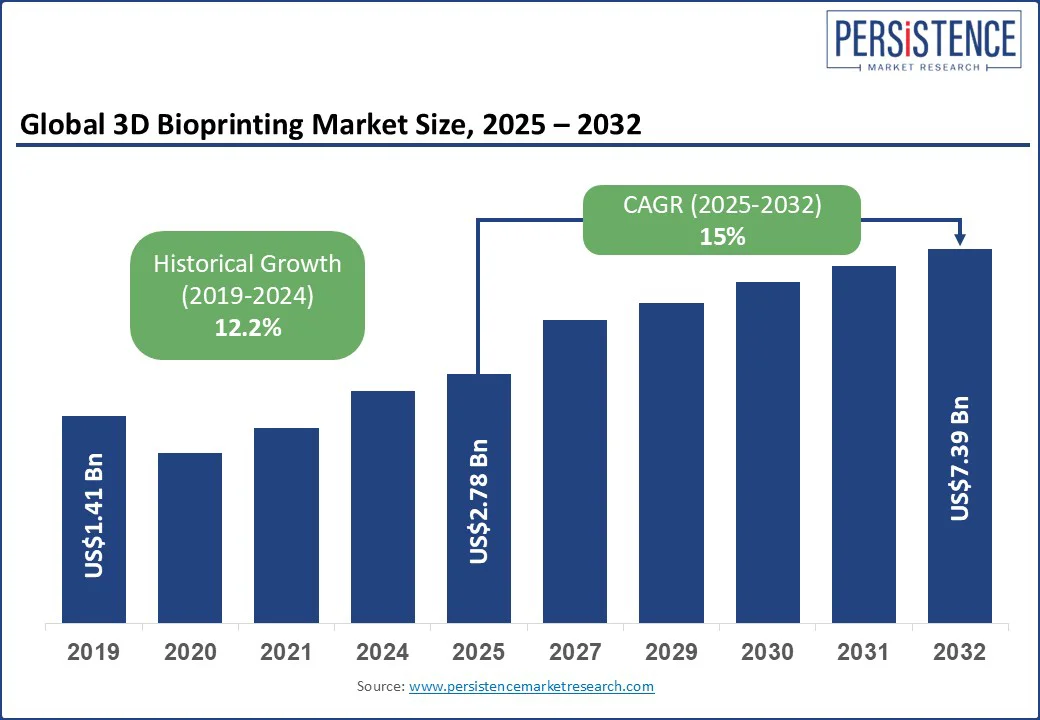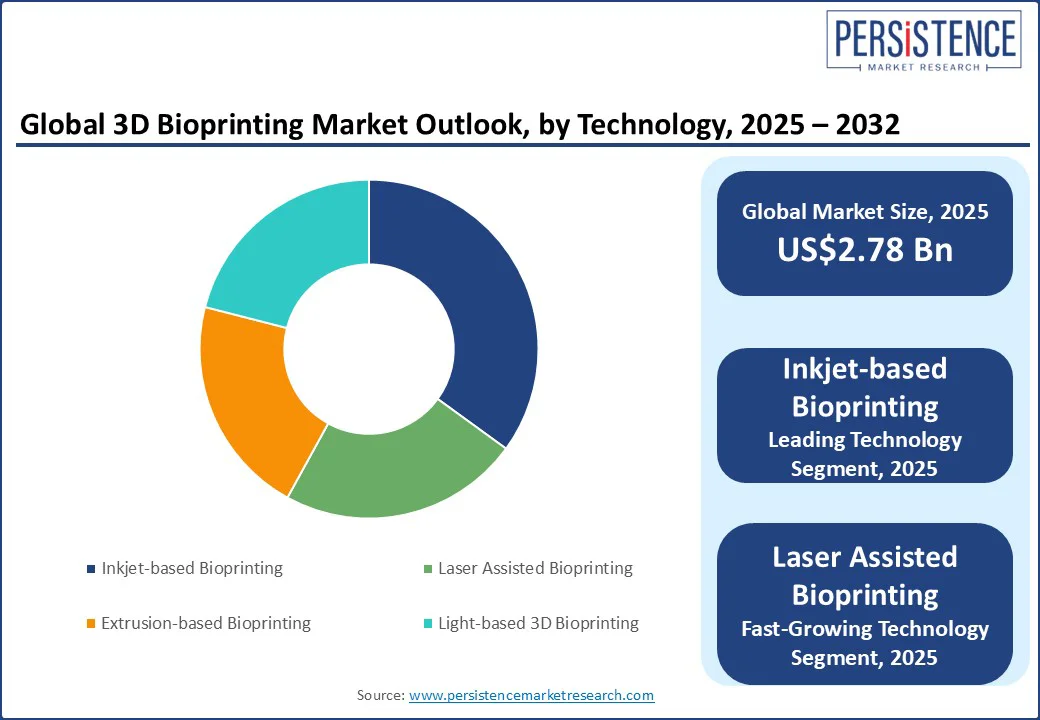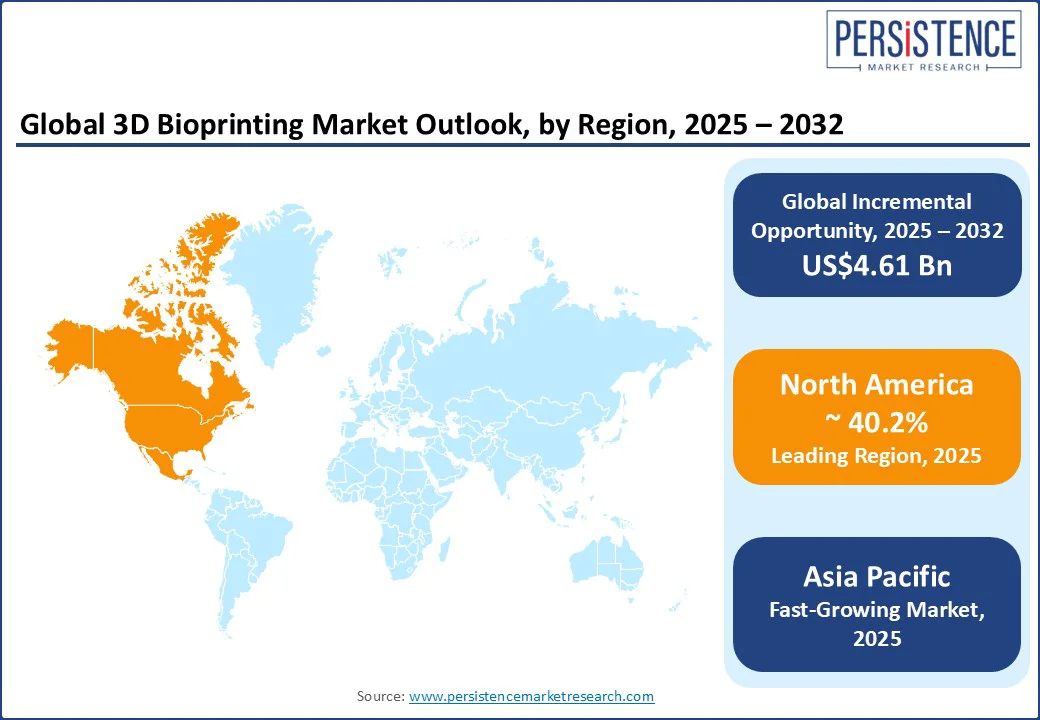ID: PMRREP3255| 199 Pages | 20 Aug 2025 | Format: PDF, Excel, PPT* | Healthcare

The global 3D bioprinting market size is projected to rise from US$2.78 Bn in 2025 to US$7.39 Bn by 2032. It is anticipated to witness a CAGR of 15% during the forecast period from 2025 to 2032.
The growth of the 3D bioprinting industry is driven by the increasing demand for advanced bioprinting technologies in healthcare, regenerative medicine, and pharmaceutical research.
A breakthrough has emerged from Penn State University, where researchers have developed a novel bioprinting technique that significantly enhances the speed and precision of tissue fabrication. This innovative method uses spheroid clusters of cells to construct complex tissue structures, achieving production speeds up to ten times faster than traditional bioprinting approaches.
In a compelling demonstration of this technology’s potential, the team successfully created a one-cubic-centimeter cartilage tissue construct composed of approximately 600 spheroids in under 40 minutes.
These advancements are accelerating the development of functional tissues and organs, moving the industry closer to the reality of on-demand bioprinted solutions for organ transplantation, personalized medicine, and drug testing. The ability to rapidly produce viable tissue constructs is bound to revolutionize the treatment of chronic diseases and organ failure. The 3D bioprinting market stands at the forefront of a new era in healthcare innovation, offering transformative possibilities for patients and practitioners alike.
Key Industry Highlights:

|
Global Market Attribute |
Key Insights |
|
3D Bioprinting Market Size (2025E) |
US$2.78 Bn |
|
Market Value Forecast (2032F) |
US$7.39 Bn |
|
Projected Growth (CAGR 2025 to 2032) |
15% |
|
Historical Market Growth (CAGR 2019 to 2024) |
12.2% |
Personalized medicine is set to redefine healthcare by enabling treatments tailored to an individual’s genetic profile, improving therapeutic outcomes, and minimizing adverse effects. 3D bioprinting is emerging as a key technology supporting this shift, offering precise, patient-specific solutions that align with the growing demand for customized care.
Unlike traditional treatment approaches that rely on generalized drug formulations, bioprinted tissues allow researchers to test medications on patient-specific models, improving accuracy and treatment outcomes. A remarkable example comes from Wake Forest Institute for Regenerative Medicine, where scientists bioprinted miniature human organs-on-a-chip to simulate real organ functions and received a US$24 Mn federally funded project aimed at developing a body-on-a-chip.
These bioprinted models are now being used for drug testing, reducing reliance on animal trials and speeding up the development of safer, more effective therapies. Beyond drug testing, personalized skin grafts, cartilage implants, and bone structures are developed using a patient's cells, ensuring perfect compatibility. As the demand for customized treatments and regenerative solutions grows, 3D bioprinting is becoming a critical enabler of the next generation of healthcare innovations.
The development of bioprinting hardware, bioinks, and complex software requires substantial investments, making these solutions expensive. For instance, a high-end 3D bioprinter can cost anywhere from US$10,000 to over US$200,000, while the bio-inks, crucial for printing functional tissues, remain costly due to their complex formulation.
The financial burden limits widespread adoption, especially in developing regions with constrained healthcare budgets. The need for skilled professionals to operate bioprinters adds to the cost, creating a bottleneck in accessibility. Without cost-effective advancements, the dream of affordable, on-demand bioprinted tissues and organs remains distant, hampering market growth despite its groundbreaking potential.
The biggest breakthrough in 3D bioprinting lies in its potential to create fully functional, transplantable organs, eliminating donor shortages. Every year, over 100,000 people in the U.S. alone are on the organ transplant waiting list, with only a fraction receiving the organs they need. Scientists have been making incredible strides recently. Researchers at Tel Aviv University bioprinted a miniature human heart with blood vessels using patient cells, reducing the risk of rejection.
Companies such as United Therapeutics are developing bioprinted lungs, aiming to end the global organ scarcity crisis. Organ failure could no longer be a death sentence if these innovations reach large-scale production. The future is inching closer, where 3D bioprinting is poised to extend life expectancy and revolutionize the overall healthcare industry.
3D bioprinters dominate the component segment with 64.7% of the total market share, driven by rising demand for organ transplants, regenerative medicine, and personalized healthcare solutions. According to the studies, over 100,000 patients in the U.S. alone are on transplant waiting lists, and 17 people lose their lives daily owing to the shortage of viable organs.
3D bioprinters offer a compelling solution by enabling the creation of patient-specific tissues, significantly reducing transplant rejection risks and addressing organ scarcity. Companies and research institutions are pouring billions into the 3D bioprinting space, further cementing the dominance of 3D bioprinters. For instance, in 2023, researchers at Wake Forest Institute for Regenerative Medicine developed a bioprinting technique capable of producing fully vascularized tissues, a major step toward printing whole organs.
Inkjet-based bioprinting led the market, accounting for 34.8% of total revenue. The key to its dominance lies in its remarkable ability to print complex living tissues and organs directly onto culture substrates. The technology’s reliability and efficiency make it a preferred choice for applications ranging from skin grafts and cartilage regeneration to the development of lab-grown organs.
As the demand for organ transplantation alternatives and personalized medicine rises, this segment is poised for significant expansion in the coming years. With ongoing advancements in bio-ink formulations and printing accuracy, inkjet-based bioprinting is set to reshape the landscape of regenerative medicine, bringing humanity closer to the reality of on-demand, lab-printed human tissues and organs.
Laser-Assisted Bioprinting (LAB) is considered the fastest-growing segment in the market due to a combination of technical precision, versatility, and compatibility with delicate biological materials. The laser-based approach is non-contact and gentle, leading to higher post-printing cell survival rates compared to extrusion or inkjet methods. This is crucial in applications where living cell functionality is essential.

North America dominates the 3D bioprinting market and is expected to retain its lead throughout the forecast period. The region's favorable regulatory environment and substantial investments in research and development have created a fertile ground for innovation.
The success of companies such as Organovo Holdings, Inc., based in San Diego, California, reflects North America's leadership and innovation in the 3D bioprinting space. Established in 2007, Organovo has been instrumental in advancing 3D bioprinting technologies, focusing on creating functional human tissues for medical research and therapeutic applications.
The region's commitment to addressing organ shortages is evident, with over 103,223 individuals currently awaiting compatible organs in the U.S. alone. This pressing demand underscores the critical role of 3D bioprinting in bridging the gap between organ supply and demand.
As North America continues to lead in 3D bioprinting advancements, the synergy between technological innovation, supportive policies, and a robust healthcare infrastructure propels the region toward a future where bio-printed tissues and organs become integral to medical treatment and research.
The growth of the European 3D bioprinting market is driven by the region's commitment to research and development, which has positioned it as a hub for bioprinting innovations. European governments are actively funding projects, and collaborations between academic institutions and industry leaders foster an environment ripe for breakthroughs.
For instance, the European Union's Horizon 2020 program has allocated substantial funds toward bioprinting research, accelerating advancements in tissue engineering and regenerative medicine. A notable development in the European landscape is the emergence of biocompatible resins tailored for medical applications.
In November 2024, Henkel introduced Loctite 3D MED3394, a sterilization-resistant resin meeting stringent medical standards, offering exceptional chemical resistance and precision, paving the way for its use in creating patient-specific implants and surgical tools.
Asia Pacific is estimated to be the fastest-growing region owing to the rising prevalence of chronic diseases and an aging population, particularly in countries including Japan and China. As of 2024, nearly 30% population in Japan is aged 65 or older, equating to approximately 36.23 million individuals. This trend is projected to intensify, with expectations that by 2070, the population will decline to 87 million, and 40% will be aged 65 or above.
This demographic shift has increased the demand for advanced medical solutions, positioning 3D bioprinting as a viable answer to organ shortages and personalized medicine needs. Governments are also playing a pivotal role in this growth; for example, China's strategic investments in biomanufacturing have propelled research initiatives, with institutions such as Tsinghua University leading the charge in additive manufacturing.

The global 3D bioprinting market is witnessing an intense competition, driven by advancements in regenerative medicine, tissue engineering, and biomaterial innovations. Established companies are leveraging their technological expertise, strategic partnerships, and R&D investments to maintain a strong market presence.
Emerging startups are introducing disruptive solutions, focusing on AI-driven precision, novel biomaterials, and cost-effective printing techniques. The increasing demand for personalized medicine and organ regeneration is fueling industry growth, attracting significant funding and research collaborations. As competition intensifies, market leaders and innovators continue to drive breakthroughs, shaping the future of biomedical applications and healthcare transformation.
In 2025, the global 3D bioprinting market is expected to reach a value of US$ 2.78 Bn.
By 2032, the market is projected to grow significantly and reach approximately US$ 7.39 Bn.
Key trends include rapid advancements in bioprinting technologies, such as the use of cell spheroids for faster and more complex tissue fabrication.
Inkjet-based bioprinting leads the market with a 34.8% share owing to its precision and speed, while 3D bioprinters dominate the component segment, accounting for 64.7% of the total market.
The 3D bioprinting market is projected to grow at a compound annual growth rate (CAGR) of 15% from 2025 to 2032.
Major players include Organovo Holdings Inc., CELLINK (BICO Group), Allevi Inc., Aspect Biosystems, and 3D Systems Corporation.
|
Report Attribute |
Details |
|
Historical Data/Actuals |
2019 - 2024 |
|
Forecast Period |
2025 - 2032 |
|
Market Analysis |
Value: US$ Bn |
|
Geographical Coverage |
|
|
Segmental Coverage |
|
|
Competitive Analysis |
|
|
Report Highlights |
|
|
Customization and Pricing |
Available upon request |
By Component
By Technology
By Application
By End-user
By Region
Delivery Timelines
For more information on this report and its delivery timelines please get in touch with our sales team.
About Author